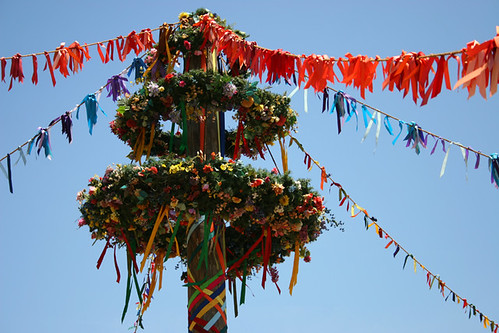What comes to mind when you think of May Day? A Maypole, perhaps, surrounded by beribboned dancers. A young woman being crowned May queen. Maybe a weird music video from the ’80s. We delved into words about May Day, and encountered some interesting origins.
The holiday itself is “a day on which the opening of the season of flowers and fruit was formerly celebrated throughout Europe.” Observances include “the gathering of hawthorn-blossoms and other flowers, the crowning of the May-queen, dancing round the May-pole, etc.” Beltane is another holiday celebrated on May first, an “ancient Celtic festival” during which “bonfires were kindled on the hills.” This custom was derived “from the worship of the sun, or fire in general, which was formerly in vogue among the Celts as well as among many other heathen nations.” The word Beltane may mean “blazing fire.”
The night before May Day is known as Walpurgis Night, “observed in some European countries and in some Scandinavian communities in the United States in celebration of spring and marked by music, singing, and bonfires.” Walpurgis Night is translated from the German Walpurgisnacht, and is named for Saint Walpurga, an “English abbess who migrated to Heidenheim, Germany” in the eighth century.
Walpurgis Night is also sometimes referred to as the witches’ sabbath, based on a German fairy tale that says on Walpurgis Night “the witches held their meetings on the Brocken,” a peak of the German Harz Mountains. According to John Michael Cooper in his book Mendelssohn, Goethe, and the Walpurgis Night, this may come from “a misunderstanding of the [German] word ‘Unhold‘ [demon].” Those “who did not want to abandon their heathen worship altogether” became known as Unholden, “unfriendly,” and “would have gone up onto the highest mountains, and therefore also up onto the Brocken, where they made sacrifices to the goddess Herda.” The word unhold would “later came to mean ‘demon,’” which caused some to believe that “witches were gathering on the Brocken.”
The morning of May Day is the may-morn, which also means “freshness, vigor.” May-dew is “the dew of May, which is said to have great virtue in whitening linen, and to have also other remarkable properties.” May-dewing is “the custom of washing the face in dew on May-day, or on the first Sunday in May, to secure lasting beauty of complexion.” A may-garland is “a wreath of flowers formerly borne from house to house by children on May-day.” May-game refers to “sport or play such as is usual on or about the first of May,” and figuratively, “frolic; jest,” as well as “one who takes part in the May-games or May-day sports; hence, a trifler; also, one who is an object of May-games or jests; a make-game.”
The Maypole “was usually cut and set up afresh on May-day morning, drawn by a long procession of oxen, decorated, as were also the pole itself and the wagon, with flowers and ribbons.” The symbolism of the pole has long been debated. Some say it stands for the world axis or axis mundi, “the world center and/or the connection between Heaven and Earth.” Another theory holds that Maypoles were “a remnant of the Germanic reverence for sacred trees.” Others have viewed Maypoles “as having phallic symbolism,” while still others theorize that they’re “simply a part of the general rejoicing at the return of summer, and the growth of new vegetation.”
A may-lord is “a young man chosen to preside over the festivities of May-day,” while the May queen, also known as the may-lady, is “a girl or young woman crowned with flowers and honored as queen at the games held on May-day.”
A maggiolata is “an Italian May-day song,” while the morris dance (derived from Moorish dance, perhaps “in reference to fantastic dancing or costumes”) is “a dance of persons in costume, especially of persons wearing hoods and dresses tagged with bells.” On May Day, the dancers “commonly represented the personages of the Robin Hood legend.”
Morris dancers
A character in the morris dance is Maid Marian, “often a man in woman’s clothes,” also known as a malkin. According to the Dictionary of Phrase and Fable, Maid Marian is a corruption of Mad Morion, “named for the ‘morion’ which [this character] wore on his head.”
So which came first, Maid Marian as a character in the morris dance or as “Robin Hood’s sweetheart”? According to the Dictionary of Phrase and Fable, the character of Robin Hood’s Maid Marian was based on a real-life “Matilda, the daughter of Fitz-Walter, baron of Bayard and Dunmow, who eloped with Robert Fitz-Ooth, the outlaw, and lived with him in Sherwood Forest,” and then according to this poem by the Earl of Huntingdon:
Next ’tis agreed
That fair Matilda henceforth change her name,
And while [she lives] in Shirewodde …
She by maid Marian’s name be only called.
Furthermore, says the Online Etymology Dictionary, Robin and Marian “have been stock names for country lovers” in French since the 13th century.
Now that you’re caught up on May Day words, you can dance if you want to, just don’t leave your friends behind.
[Photo credit: “The Maypole,” CC BY 2.0 by April Killingsworth]
